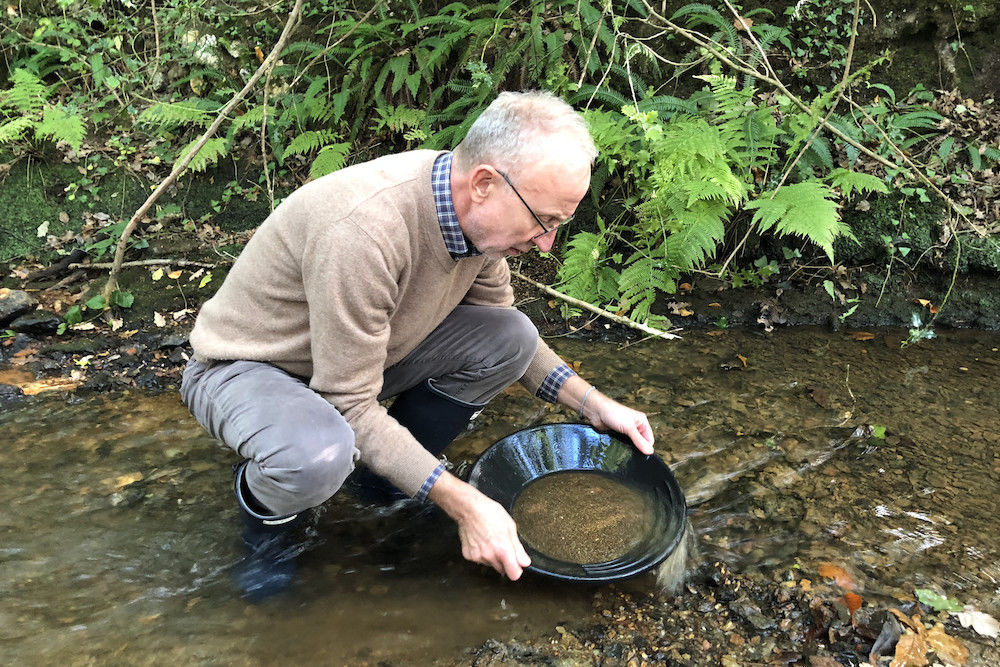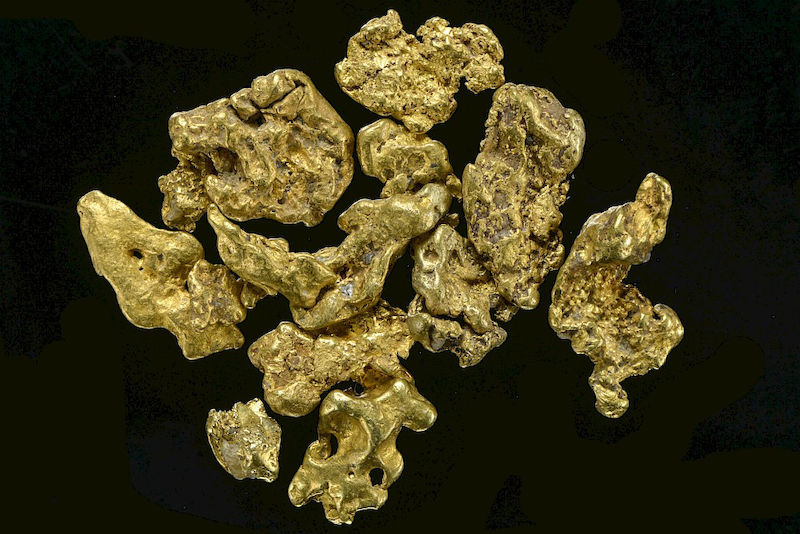The trail leads to Cornwall

Hardly any other archaeological object has been as intensively studied in recent years as the Nebra Sky Disc. The Sky Disc is the oldest concrete depiction of the cosmos and was discovered by looters on Mittelberg hill near Wangen. Since 2004, it has undergone scientific scrutiny many times at MLU. The Deutsche Forschungsgemeinschaft (DFG) set up a research unit to examine many aspects of the more than 3,600-year-old artefact. Spectacular research findings have emerged again and again, for example, the astronomical and calendrical functions of the depiction of the sky have been deciphered, which has excited both the scientific community and the public. The Sky Disc has a cult following and this is not likely to change anytime soon. Even more so as its secrets are still being unlocked today.
One of the questions surrounding it involved figuring out the origin of its approximately 32 grams of inlaid gold. Investigations into this started at the time that work on the Sky Disc began. But comparisons of natural gold from Europe with the gold on the Sky Disc came up with no matches. Finally, there were clear scientific indications that the gold originated in Cornwall, England, however there was no concrete evidence to back this hypothesis.
In May 2017, luck took centre stage in this scientific thriller. At the time, Harald Meller, the State Archaeologist of Saxony-Anhalt, Director of the State Museum of Prehistory in Halle and an honorary professor at MLU, and Gregor Borg, a geologist and expert in economic geology at MLU, were just about to head off to England. The two men were scheduled to hold a talk on the gold of the Sky Disc at the Royal Cornwall Museum in Truro. Meller also wanted to see the Carnon River which flows through the area. There were suspicions that it too might have played an important role in gold mining in the former mining region. Shortly before leaving, Borg received a call from Courtenay Smale. The 84-year-old Briton was president of the Royal Institution of Cornwall. He is also a passionate mineral collector and the curator of the mineral collection at Caerhays Castle, a manor house overlooking a picturesque bay on the English Channel. Smale indicated that he had discovered something interesting in the castle’s collection: While combing through its inventory, he came across a box containing several gold nuggets, each measuring one to two centimetres and weighing up to ten grams. They had most likely been found in Cornwall and he asked Borg if he wanted to examine them. He conjectured that they could have the same composition as the gold on the Sky Disc.
Gregor Borg could hardly believe his luck. “That would prove that our previous hypotheses on the subject were correct.” On site, the experts noticed the very high silver content and other characteristic metals in the nuggets. Small black inclusions were also detected on them. “It was assumed that this was cassiterite, i.e. tin oxide,” explains Borg, adding: “This is a special feature of the mines in Cornwall. Gold and tin appear together there because gold nuggets and cassiterite were transported down the nearby Carnon River when mining was conducted in the region. The cassiterite inclusions stand out for their two very different shapes: well-rounded and sharp-edged angular grains.”
First the inclusions underwent non-destructive testing in the laboratory using X-ray analysis equipment. Then images were created using a 3-D microscope. The testing confirmed that it was indeed cassiterite. And there was more: “Cassiterite associations in which these two different forms of grain occur together are extremely rare. However, precisely these grain forms had been described years ago as being typical to industrial tin production along the Carnon River.” – Another indication that the nuggets came from the Carnon River in Cornwall, explains Borg. “The nuggets and the cassiterite provided us with enough proof that our assumption was correct.”
As early as 2011, the researchers were able to prove the characteristic geochemical similarity of the gold from the Carnon River with that of the Sky Disc through museum samples. However, discovering the geological origins of the special composition of gold required additional research and an explanation. “This additional work enabled us to provide unequivocal proof,” says Borg.
Looking back today, the case sounds absolutely watertight. But what now seems like an open book to scientists has been the culmination of wrong turns, dead ends, happy coincidences and strokes of luck. “Research and knowledge gains are not always in sync with the cycle of DFG projects,” says Borg. In fact, research often comes to a standstill at the end of a project’s funding phase. The fact that this did not happen in the case of the Nebra Sky Disc, is, of course, down to the significance of the find, but also because the many pieces of the jigsaw puzzle, though they surfaced at different times, have always turned out to fit.
Gold as a long-time companion
Gregor Borg is an eminent expert in the search for and the mining of gold. In the 1980s and 1990s he discovered two gold mines on behalf of the German government and the country of Tanzania as well as an international mining company. Today their value totals around 2.55 billion US dollars. The 62-year-old first discovered his love for the precious metal during his doctoral studies. At that time, he learned to rely on his instinct during excavations. As a doctoral student he had stumbled across gold in a mine in Namibia, even though the operating company had assured him that he would never find anything there. “A pivotal experience”, says Borg. But gold has an aesthetic value for him as well. It’s a warm, soft metal and “calming to the touch”. And, in Borg’s experience, it regularly causes a stir. “In the course of my career I have learned that there are two things in life that make people act irrationally: gold and cars.”
As part of his work on the Sky Disc, Borg initially compared its gold to that of other archaeological finds. He used a database that contained around 4,000 gold artefacts from Europe that had been catalogued in the 1970s. This revealed that specific types of gold artefacts occurred in different parts of Europe. Based on this finding, the first DFG subproject under Borg’s leadership was initiated in 2005. Over a period of six years, samples were taken and analysed from around 200 gold deposits in Europe. Two doctoral students worked their way first from the deposits in Central Germany to those on the Rhine and later to the Alps and Transylvania. They produced nearly 1,500 gold analyses. However, success was a long time in coming. None of these gold deposits were a geochemical match with the gold of the Sky Disc. “That was frustrating,” says Borg, adding, “all the work we put in was nevertheless important and insightful. After all, it enabled us to rule out certain regions as the places of origin of the gold on the Sky Disc.”
It was not until 2008 that Anja Ehser, another doctoral student, began studying gold deposits in Spain, Ireland and Cornwall. Success came in early 2011 when she identified the closest match for the gold on the Sky Disc in Cornwall. In the same year, Borg and his team were able to publish the findings. This enabled an important conclusion to be drawn: “This discovery suggests that there were economic ties between Central Germany and Cornwall during the Bronze Age,” says Borg.
Though the mystery surrounding the gold has finally been solved, the Sky Disc will probably not let go of Gregor Borg so easily. “As soon as there is a new line of inquiry, research will most certainly start up again,” he says. He also points to scientists from the British Museums in Cardiff and Edinburgh who are applying for funding for a research project to investigate artefact gold and natural gold found in the British Isles. The investigations into the gold of the Sky Disc will serve as a blueprint. Says Borg: “The British have already asked me to be their scientific advisor.”
Borg and Meller’s extensive knowledge of the Sky Disc is frequently in demand. As recently as September, a documentary film was broadcast as part of the ZDF series “Terra Xpress” on which both had collaborated. Borg has also worked intensively on an article on the subject for the Journal of the Royal Institution of Cornwall in which he reviewed the research conducted over the past 15 years. And just a few months ago, Harald Meller published his latest book on the subject in collaboration with science journalist Kai Michel. It is thanks to his hard work, but also to his presence and enthusiasm, that the Nebra Sky Disc at the National Museum of Prehistory has been repeatedly brought to the public’s attention and was even included in the UNESCO World Heritage List in 2013. “Starting in November 2020, we want to satisfy the unwavering fascination for the object through a major special exhibit at the State Museum in cooperation with the British Museum,” says Meller.
Professor Gregor Borg
Institute of Geosciences and Geography
Telephone: +49 345 55-26080
Mail: gregor.borg@geo.uni-halle.de
Professor Harald Meller
State Office for Heritage Management and Archaeology
Telephone: +49 345 5247310
Mail: hmeller@lda.stk.sachsen-anhalt.de
Further articles
Gold fever
Researchers solve mystery surrounding the Nebra Sky Disk – with a precious metal playing a decisive role in more than just the famous Bronze Age discovery. Read more
Early networks
For eight years, Professor François Bertemes coordinated research on the context of Nebra Sky Disc. The discovery of the disc has prompted archaeologists to completely rethink their notions about life in the Early Bronze Age. Read more
The tiny philosopher’s stone
The bacterium C. metallidurans is most notable for its perseverance, thriving in areas contaminated with heavy metals. It has attracted the attention of a research group in Halle, led by Professor Dietrich H. Nies, but for an entirely different reason: it produces microscopic gold nuggets. Read more

